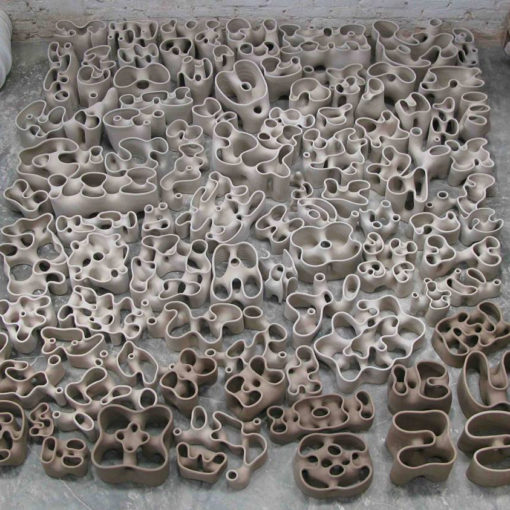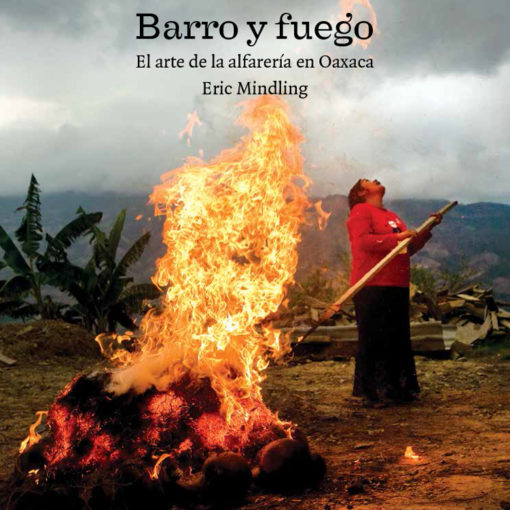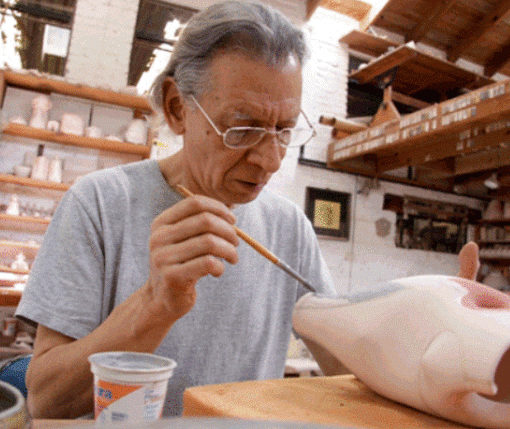In order to see something new it is necessary to make something new
G. Ch. Lichtenberg.
It is obvious that to approach the subject of “Modernism and Beyond” from a historical point of view is much more a task for art critics and historians, who by the way have done it and quite thoroughly (I think specially in Garth Clark’s several illuminating essays). Being myself a ceramist, a potter, and in no way academically qualified to do it, I have to try it because of a personal necessity to understand a little better the reality of ceramics in our time.
Ceramics is fired clay, and this precise, simple and all comprising definition could seem somehow sufficient to appreciate whatever belongs to the wide field of our craft. Our senses give us definitely the most direct and rich information about it. But it is important to acknowledge how, in very many ways, whenever we approach a piece of ceramics (and of course any other man-made object), besides this direct sensorial experience we do it also, necessarily with a very complex and rich amount of experience. We always know (or guess) some facts about it, sometimes many facts; its provenance, the time when it was made, the technique used to make it, the kind of clay, the kind of glazes, its character as utilitarian or as artistic object, etc., and we even know certainly if we like it or not.
At the same time it is just as true that after the initial direct approach to any piece of ceramics there remain necessarily many other questions to be faced. First and foremost there is always the deep mystery of why a specific individual or group of individuals had to make what they made. This is of course something that ultimately we cannot know, and yet, there are certain ideas that are worth analyzing in order to get a clearer image.
The initiative of Sue Jefferies resulting in this exhibition at the Gardiner Museum implies such an analysis, or better the definition of certain curatorial criteria, which throw a light on important aspects of the development of ceramic art in the second half of the 20th century. Classifications are very often artificial and forced. In order to reinforce a certain idea, the results might instead of clarity only produce confusion and mystification instead of the desired clarity. Arbitrary and artificially constructed groupings have such effect. In this case, however, the idea behind the exhibition is thoroughly justified; it is perfectly clear for anyone who regards attentively the development of ceramics, that the moment when Lucie Rie, Hans Coper and Ruth Duckworth started producing their work in England, and a little later Peter Voulkos and John Mason in California, meant a definitive change, a turning point in many respects, and, indeed, the precise moment when ceramics reached modernity.
We only need to think of music, literature, painting, sculpture and other arts to see clearly that the efforts of the best known European ceramists at the time had really no correspondence with what, for instance, Stravinsky, Joyce, Kafka, Buñuel, Picasso or Brancusi were making or had already done. Dadaism, Cubism, and Surrealism were no longer new at a time when ceramists in England and Europe in general (the Art Deco movement in France as another example) seemed totally impervious to the current of their time, apparently unaware of the profound changes that were taking place in other arts.
While it is of course impossible to neglect the work of Leach, Cardew and Staite-Murray, important as antecedent but also meaningful in itself, it is necessary to look at it critically too if we want to understand what came later on. Them, and many others as well, did certainly work towards a redefinition of ceramics, each one of them attempted at going to the roots, or at least so they thought. Their idea of going to the roots, however, was not a radical one; in fact it was rather conservative, even superficial. We only need to think of what Bela Bartok was doing with Hungarian and Rumanian folkloric music, or Brancusi with Rumanian popular sculpture, to perceive that everything Leach did in relation with Japanese ceramics, or Cardew with traditional English pottery was at its best a sort of recreation of their chosen models, a much too timid approach, a comfortable continuation compared with the spirit of revolt that animated so many other artists, their strict contemporaries.
Significantly enough it was three Jewish émigrées, Lucie Rie, Hans Coper And Ruth Duckworth who had to open the path to break away from the established studio potter movement. Historical facts made it necessary and possible for them to take a quiet but definite stand against the strongly inflexible attitude they were confronted with in England. Not that it took them too long to get attention and recognition (they were just too good and too strong to be ignored), but their task was by no means simple, and the arrogant annoyance Leach, Cardew and Staite-Murray felt for the newcomers has been well documented.
It was the First World War and its dreadful sequels, which forced open the door to Modernism in other arts. Ceramics had to wait for the still more dreadful Second World War to find its way into it. The reasons for this delay are in fact not strange at all. There had been for so many centuries a neglect, a lack of serious artistic consideration of the production of ceramics, thought for a long time to be fatally condemned to become industrial; the efforts to elevate it as a form of art had to be huge. Although even today it is often necessary to reclaim the spaces ceramics more than deserve, the recovery of our craft in the last 50 year is, nevertheless, astonishing..
And I say recovery because we must remember that the history of ceramics is a very long one. Thinking that the arrival of Modernism is the first moment of great artistic quality in ceramic production is totally wrong. The history of ceramics is far older and wider than the history of Europe in the last millennium. There has been of course the East, Korea, China and Japan, a whole world of fantastic achievements. There were Mycenae and Crete, Egypt and the Middle East. And in America, the Olmec, the Maya, the Zapotec, Inca, Totonac, Aztec and a long etcetera. Through the millennia great artistic quality had been achieved many times and in many different places in the world. It is significant and paradoxical at the same time that the European Renaissance should have meant for ceramics, with few exceptions, this dark period, which lasted several centuries. The exaltation and fast development of the so called major forms of art, and the neglect of the others, minor arts, the crafts which were sort of taken over by industry. Ceramics was among the latter, but naturally not forever.
It would be misleading and unnecessarily rhetorical to picture the development of Lucie Rie, Hans Coper and Ruth Duckworth in England as heroic, or to imagine them as the conscious leaders of some avant-garde ambitious and noisy movement; no, as good ceramists they knew better, and having clay as the true master clay can be, their work should have developed as it always goes with clay, in silence and seclusion, far away from the limelight that only time brought to their work, and then, incidentally to themselves.
Their example however, out of that silence, has been extraordinarily powerful and fruitful, it has meant a landmark for almost every ceramist, in the last fifty years. What is exactly what we have learned from them is difficult to define, but I can think of some aspects that stand out distinctively. First of all, their profound commitment to craftsmanship. In order to make their work they did not need to break away from the basic characteristics of pottery. Thrown or handmade, pot or sculpture or relief, the quality of their craftsmanship is evident and true to tradition. Also, I find in their work the basic intention of investigating. Not the need to be true to any source or tradition, but following basically the direction determined by their interest, their curiosity to try and to find out. As Ruth Duckworth has declared, “the whole point of what I do is to do what is interesting”. Not attempting consciously at expressing something concrete, but more into a research, a personal investigation of the endless possibilities of the interplay between mind and hands, between clay and fire. The results of their work, nevertheless, are certainly expressive, but the starting point, the initial intention was not.
All this resulted in an impulse that has proved definitive. I think that it is not exaggerated to say that nowadays, in Post-Modern days, ceramics has finally reached the character and the quality that fits and belongs to our time. Not anymore an easy to place minor, slightly anachronistic form of art, but a medium in which many all over the world are discovering and stating strongly what ceramics can transmit as no other medium can: sensations. And this should help to explain why the response of viewers to it is so strong. Ceramics can be looked at critically and thought about, it can be appreciated from many different points of view, but what always happens first is that the sensations that ceramics transmits are felt, almost physically felt. There in its force, its specific force.
All this happens in relation with a historical reality that surrounds and to an extent determines what we are and what we make. Just as with scientists and all kind of intellectuals, the responsibility of an artist is a permanent questioning. Of course, the basic and essential questioning should refer to the problems of his specific discipline, his relation with the indispensable critical and inquisitive research that creativity implies, but there is no valid way to evade the need for a wider view, a concern and a commitment with all that happens around it, the reality in which our personal development has to find their place.
Whatever the real definitive reasons might have been which could explain the big changes we perceive in ceramic art at the time when Lucie Rie, Hans Coper and Ruth Duckworth started their silent revolution, it is necessary to acknowledge an evident fact: their situation was far from comfortable. They were not only trying something new, which demanded determination and talent, but they had to do it in an unknown atmosphere, and probably, as it is recorded, facing, to put it mildly, a certain resistance. It is impossible to say that they would not have been able to do what they did had their circumstances been different. In their home land, not prosecuted, not exiled, not having to face the hardship of the war and the postwar period, but I cannot help thinking that somehow it was their specific condition which forced or allowed them to grow as artists the way they did.
And it is from this point of view that I would like to call your attention to the very complex tie that we have with the social, political, economical and environmental situation that this beginning of the 21st century confronts us with. It is impossible to evade the consciousness that this is a crucial, and critical moment, and this time, for the first time in history, for the whole planet. Globalization is an ineludible fact, and in many respects an awfully unfair fact indeed. The planet sharply divided in two in spite of the pretended unity that globalization claims to be producing, while in reality it is only aiming at a catastrophic situation which is evidently of no concern for the politicians and the ones that cynically dare to call themselves the owners of the universe.
Coming from one of the many countries where this reality faces its darkest sides, it is for me necessary to face the very hard question of what is really all our effort about. Being an artist is indeed a privilege, the possibility and the necessity to spend our time in an individual and so often enjoyable research while at the same time for so many others (60% of mankind to be precise), life is increasingly hard, almost impossible to endure.
Art cannot change the world. If it could do it, the world would have to be different, since the contributions of so many all along history have been certainly immense. To no avail; there have been awful wars, there are awful wars. Injustice has never ceased to be the rule, corruption pervades almost everything that has to do with social organization, the natural resources of the earth are very critically endangered, poverty affects two thirds of its population and keeps increasing. No, art, great art, extraordinary art apparently has not helped at all to make a better world, and sadly we have to accept that it probably never will.
There are not many reasons to be optimistic about the future, there seems to be at the moment very little that the consciousness of the conscious individuals in the world can do to change and control, or at least restrain, the powerful trends evident in global business and politics. And if it is not going to be as artists that we can have an influence on this, we must assume our role as citizens, a task that we should face with creativity and decision. I believe, I want to believe that the only possible way out lies in the development of the consciousness of so many people that somehow can force the ones supposed to be in charge to follow the orders of the majority towards a more positive possible future. Though this remains unlikely; we must remember that there are already in the world many people radically engaged and working in this direction: the anti-globalization movement involving the youth and many marginal sectors in the whole world; the neo-Zapatista movement in Chiapas, a seed of determined exigency for democracy and justice for the millions of neglected Indians in Mexico, the many ecological organizations pressing hard for a stop to the unconscious exploitation of the natural resources of the planet, many intellectuals, writers, and many artists too.
As ceramists, however, we do not need to stop. I have the definite certainty that we will continue to do what we have to do, devote our time to our work, “responding to a deep urge between my hands and my mind”, as Ruth Duckworth said. Trying to be aware of the reality that we live in, and committed to stand where our energy as citizens is required, but at the same time continuing working with clay simply because we cannot do otherwise.
Art has a social signification, yes, but on a metaphorical level only.
H. Broch.
Read during the exhibition Ceramic modernism: Hans Coper, Lucie Rie and their legacy held at the Gardiner Museum of Ceramic Art, May 25-Sept. 2, 2002.



